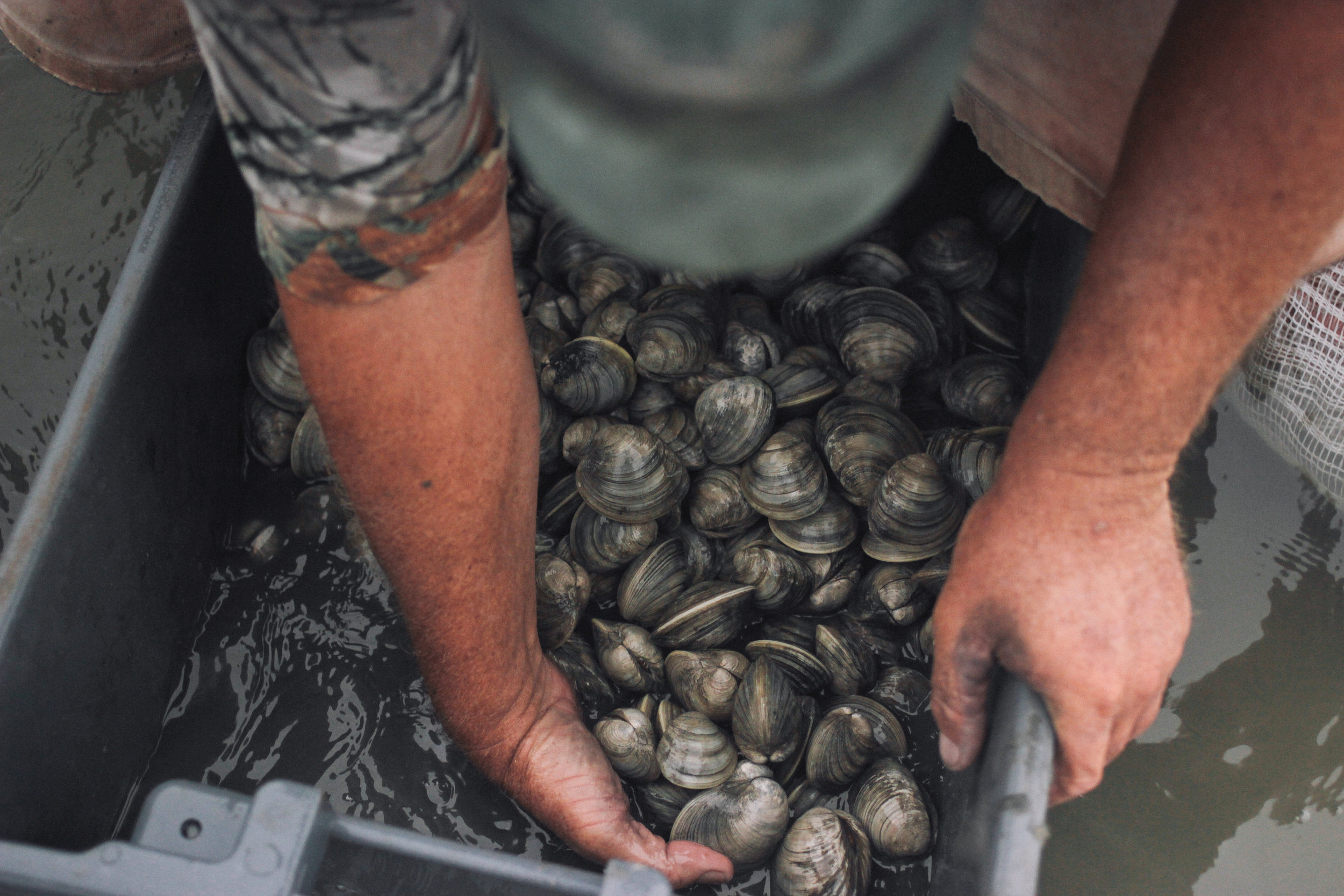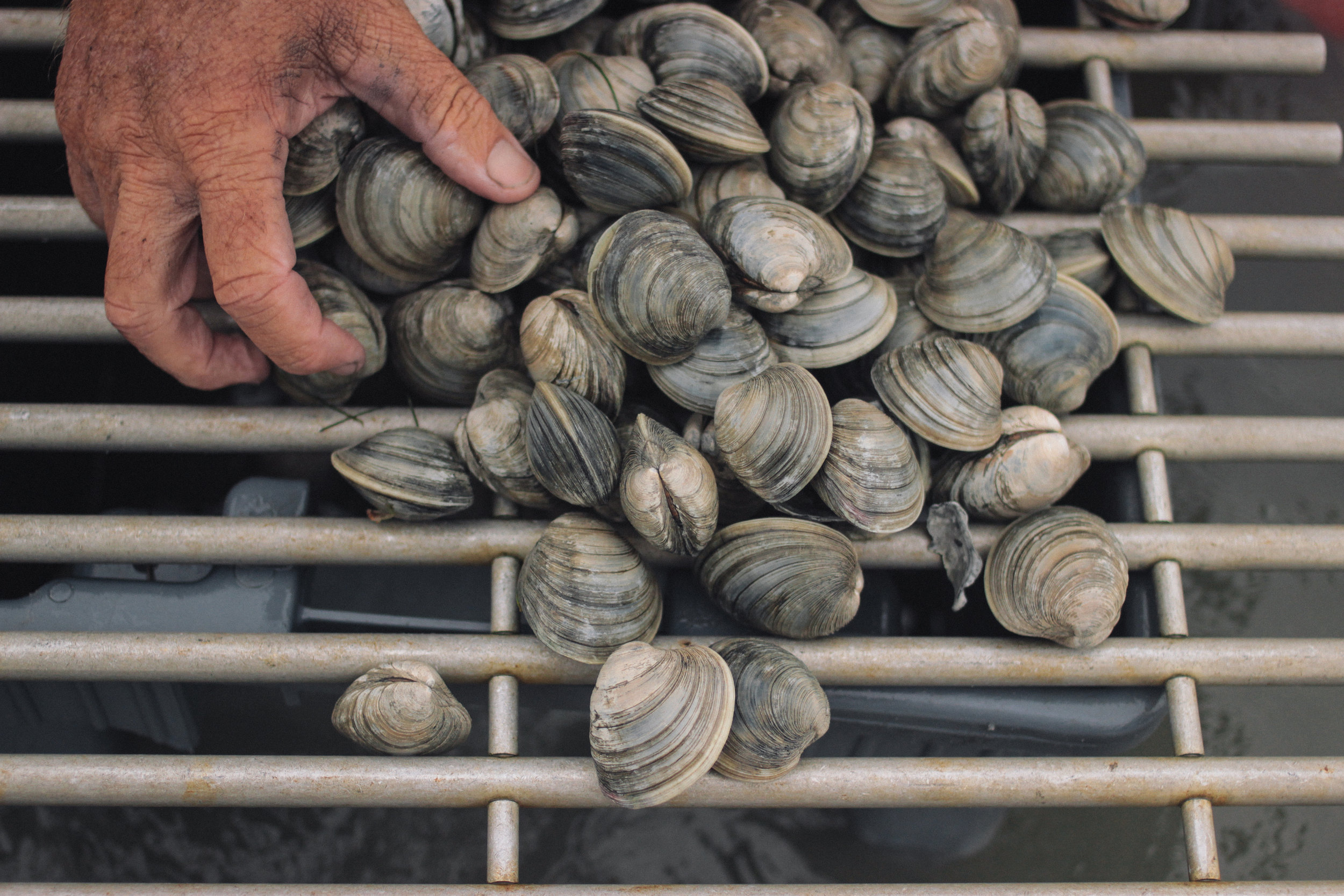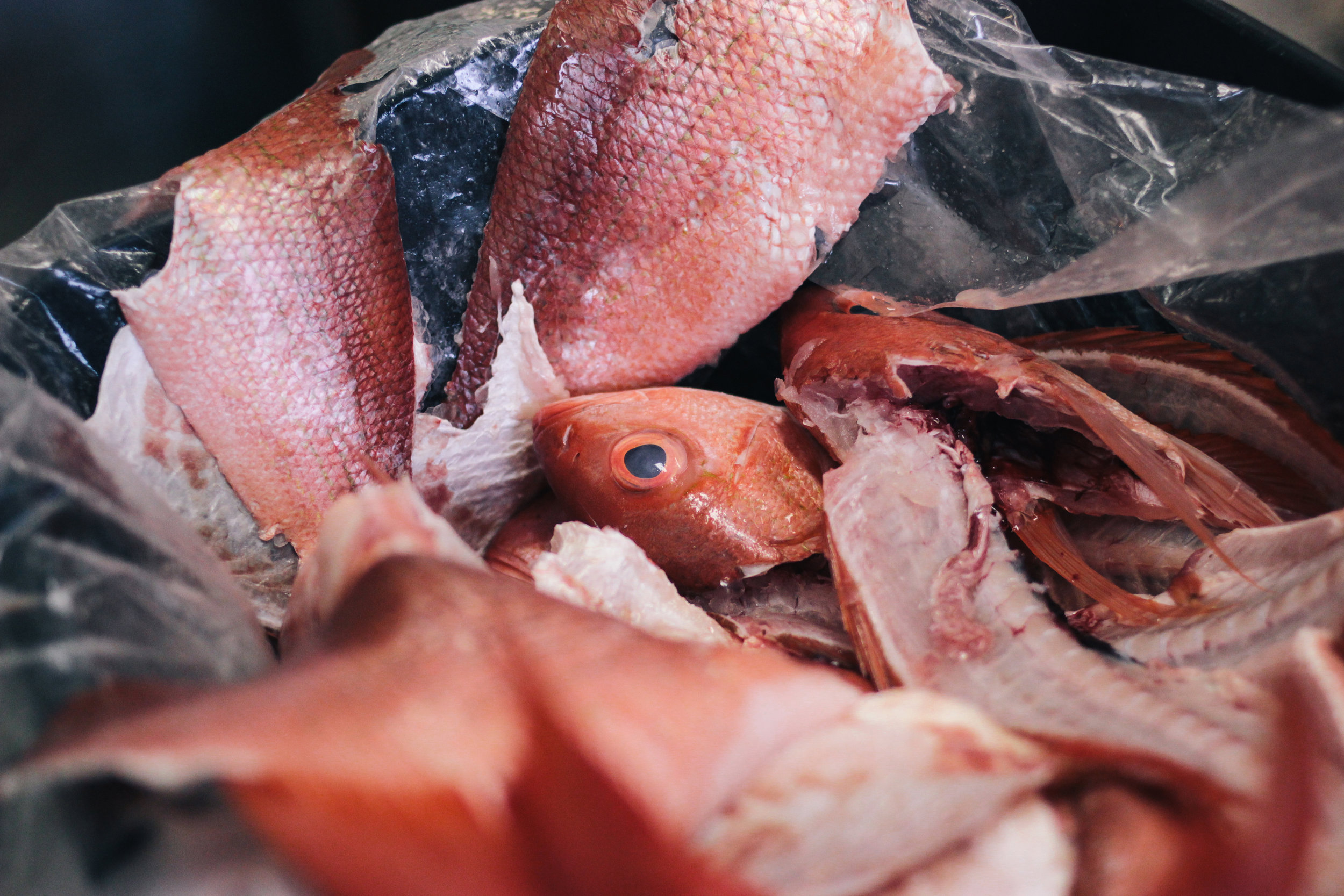Sea to Table
Originally published in Carolina Shore. Words in italics are my personal asides that would not have been a good fit for the original article. A warning to my tender-hearted friends: there are some images/mentions of fish cleaning - if you find that troubling, this is not the article for you.
Seafood is a large part of coastal life - catching it, cleaning it, selling it in restaurants, in local markets, shipping it west, taking tourists out to catch it for themselves, seafood festivals up and down the coast - it’s a vibrant part of both the economy and normal life. According to statistics from the NC Division of Marine Fisheries, last year fishermen statewide landed 60 million pounds of seafood (Carteret County contributed eight million of those pounds), a value of $94 million. A paper jointly published by Sea Grant and Duke’s Nicholas Institute estimates that seafood-related work makes up about 9,000 jobs across the state of North Carolina. But we rarely think about all the skill, labor, and family history that goes into harvesting the food we find on our plates.
To get a sense of the work that goes on every day to supply homes and restaurants with fresh seafood we followed the trail from sea to market, starting with an afternoon spent clam digging with Paul Russell and friend and collaborator Debbie Callaway. Both Paul and Debbie have their roots in commercial fishing, from past generations and many mutual friends who have done it all their life. Any names that came up on the ride from Beaufort out to Shackleford Banks they somehow knew, or knew that their parents or grandparents knew. Paul’s grandfather bought clams from local fishermen and sold clams to buyers up north (he can remember his grandfather’s hands being littered with scars from shucking accidents). Debbie’s grandfather was also a clammer, and between work on the water and as a cook, he supported a family of nine in a two-story house.
Like many independent commercial fishermen, Paul also has another business to supplement his fishing income. On the days when he’s not out on the water, he can be found doing yard work. In the summer grass only grows when it rains, and when it rains the powers that be shut down shellfishing from the bottom. So it all works out. He must’ve developed a sixth sense that allows him to get while the getting’s good, because once we had all disembarked and started working our way through the low-tide beach, he was finding five clams to our one.
Seriously, it was both hilarious and infuriating. He enjoyed chuckling at my meager attempts at clamming, then took over the rake and immediately found three clams.
Clams come in all shapes and sizes. Buttons are the ones that are too small to keep, and then there are Chowders, Cherrystones, Top-necks, and a couple of others. Quahogs are the really big, grandaddy clams. No one seemed to know why they’re called that, but they can be found all over our hemisphere, from Prince Edward Island in Canada to the Yucatan Peninsula in Mexico. When asked what makes a good clam, Paul replied high salinity for a clean clam, and quick growth for tender meat - but not too quick, or else you lose quality. He set about digging where there were trickles of water running through the beach that had just appeared. Some clammers can spot where the clams have hunkered down into the sand by small indents, but it’s not an altogether reliable tactic if you haven’t developed the skill and polished it carefully. There are also multiple methods for harvesting clams once you find a cache: dredging (favored by large-scale commercial fishing operations, cursed by the small-time operators and environmentally-minded people), spotting them and then reaching down into the sand to retrieve them with your hands (Paul said this is the way prefered by some of the Harker’s Island boys, and with their seventh/eighth generation fishermen, who’s to argue with them?) and raking through the mud (Paul’s method, which on an average afternoon gets him 800 clams).
As he worked, Paul answered questions, stopping every now and then for a longer story that required more attention. He couldn’t seem to talk without using his hands, which after a few minutes are charcoal black on the palms. It’s the oxidation from the clam rake’s handle. This rake has served him well, though. It’s been through eight sets of teeth because the sand will eventually wear them down, but the core has held up.
“It’s one of the best rakes, the guy who made it’ll tell you that. He’s arrogant.” This was said with a small laugh, and the sense was that the rake-maker was an old friend who had been told he was arrogant a couple hundred times. “I told him the thunder makes the noise, lightning does the work. Someone’s got to pull this pole.” And pull he did, for four hours, as he does any clamming day. For four hours, he raked through the heavy low tide mud. Every so often, he would feel a clam hit the rake with a small clank. He would pull it up to the surface, and turn the rake over to examine his specimen. In most cases, he could tell with a glance whether or not it is big enough to keep. If so, the rake goes in one mechanical motion back behind Paul, hovers over the rubbermaid container that he dragged behind him, and turns over, plopping the new clam in with all the rest. If the clam is too small, he tosses it off to the side (the ones he isn’t quite sure of he can put through a gauge, tied to one of the harvesting buckets; if the clam slides through the one-inch slit, it gets to live another day). And so it went, all afternoon. Rake, check, plop. Rake, check, plop. Every now and again the sameness was broken by finding a conch or a horseshoe crab so tiny, it would just about fit in the small of your hand. Once or twice he and Debbie would look up at the wild horses who had emerged to see what was happening on their banks. Then right back to rake, check, plop. It was efficient, calm, and almost comfortingly the same.
I have to admit, the horses were a big highlight of the day. For twenty years I've only seen them from a distance, and on this day they were walking right up to say hello! There are rules from the Wildlife Commission about humans staying thirty yards away, but if the horses choose to break that rule there is not much you can do.
Paul said he is always thinking when he is out there. He has a bachelor’s degree in biology, and told me the biggest gift college gave him was learning how to learn.
“If you don’t learn something every day of your life, you’re probably going backwards,” he said as he pulled the rake towards him. He also has excellent taste in literature, citing Nathaniel Hawthorne as an author of choice. So he has plenty to think about as he keeps working his way through the sand - rake, check, plop.
After a couple of hours it was time to get back in, back to Beaufort. A thunderous-looking storm was rolling in, the wind was picking up, and no one was particularly in the mood for a game of chicken with Mother Nature. In the rising tide, Paul cleaned the clams he had gathered, washing off all the mud and bits of seagrass that had made their way into his bucket. He finished filling out a wrinkled form stating when he started harvesting, where he harvested, how many clams he kept, and when he finished. After getting back to shore, he left quickly, so he could get his wares into a cooler. The next day, he would drop them off with Bill Rice of Fishtowne Seafood in Beaufort.
Like many other people in the commercial fishing industry, Bill grew up surrounded by seafood. His mother bought a commercial fishing boat when he was young, and they would go out harvesting anything that was in season, and bring their catch home for dinner. It was always a hands-on experience, with processing just being a normal part of dinner prep. Fresh out of college, he and a friend got a grant to study lower-volume, higher quality seafood. After the study was over, they both went on to work on separate endeavors, only to come back together in 2004 to start Fishtowne. When our interview started, two men were in the kitchen hosing down a load of fish. Noticeably absent was the too-salty, low-tide scent we have all come to expect from the seafood section of big box stores. The products brought in were caught a day or so before, and processed with careful efficiency. Spots were being prepped for the display case and vermillion snappers were being cleaned, filleted, and skinned for a special order, in a way that made it look like second nature.
“I’ve been doing this for twelve years,” the snapper guy said, pinning down the red tail and sliding his knife just under the skin of the snapper. “It’s not as easy as I make it look.”
For Bill, an average day is spent around the shop - weighing seafood that local fishermen bring in, waiting on retail customers, overseeing the actual processing, and doing office work. A not-average day happens every couple of weeks, when he gets up early, loads up a refrigerated truck, and heads west. Although his final destination is Raleigh, he has several stops along the way for restaurants that prioritize fresh local fish. In Raleigh, he will have a line of people waiting to see what seafood is in store for them, as members of a co-op called Walking Fish.
The guy lifting the bucket of fish was a hoot. I meandered over to his corner of the kitchen and parked there for a while for photos, telling him to let me know if I got in his way. He cackled, "You'll know if you're too close if a fish scale gets on your lens!"
In 2009, Bill went on a trip with a group of graduate students looking into the idea of taking the community supported agriculture (CSA) business model, and applying it to fisheries. They went to the first community supported fisheries in the country, driving through the coastlines of New Hampshire, Massachusetts, and Maine. At a time when the economy (local and otherwise) was in the tank, the CSF model was a viable option.
“It certainly opened my eyes up to another way to do business, another idea that could help … They were looking for something to sustain themselves, and it provided really a beacon of hope that the consumer, the consuming seafood public, was interested in and cared about the fishermen, their life, and their lifestyle (their heritage), and their product. They wanted to support it, through the community.” Shortly after the trip, paperwork had been drawn up, and Walking Fish was born: a collective of commercial fishermen banding together to get their product to consumers in the Research Triangle.
A Walking Fish member buys in for one season (about twelve weeks in spring or fall), with several options: They can either sign up for a two pound or four pound share, to be picked up in Raleigh or Durham, every week or every other week. What will be in their cooler? Whatever is in season. People seem to enjoy the variety - something different every week - and love the recipes and prep suggestions that accompany each delivery. Debbie Callaway is the director of communications, in charge of maintaining an online presence and writing up a newsletter for every week of the season. The newsletter provides customers with information on the seafood being delivered and the fishermen that caught it, along with recipes and prep suggestions. Even the recipes are sourced locally for the most part, like Debbie’s aunt’s recipe for jumpin’ mullet, or her grandmother’s instructions for clam chowder. Walking Fish is going steady, with 2-300 members receiving a little piece of the coast every week during the season (Debbie noted that membership swells in the fall season, which begins September 19). Bill, who in addition to sourcing Walking Fish’s seafood is now the President of the Board, estimated that Walking Fish has probably carried and sold 5-600,000 pounds of seafood since its first delivery in 2009. This model is a win-win: it helps the one-man fishing operations compete by gaining access to a new market, and it gives the customers a traceable source for their seafood. Whether you buy from Walking Fish or Fishtowne, Bill knows the fishermen who bring in their wares, and tries to pay them a little bit above market value.
“By using that brand of local people, it sends that message to the consumer … we have really stuck to the fresh, local. And traceability, accountability, reliability leads to credibility.”
So next time you are sitting at dinner, staring at a table filled with seafood, stop for a moment to think about where it came from. If it is locally sourced, chances are that steaming bowl of clam chowder was harvested by a man who spent the four hours of low tide raking in a steady pattern. Those pink shrimp were likely caught by a person whose grandaddy’s daddy’s daddy moved down to the coast and started a family tradition of commercial fishing. Who knows, that perfectly-battered flounder that’s calling your name could have been caught by one of those ninth-generation fishermen, there are quite a few around here. The food on your plate is continuing a grand family tradition of hard, skillful work brought to you by blood, sweat, tears, and saltwater.
Fishtowne Seafood is open year round, 9-6, Monday-Saturday.
For more information on Walking Fish, visit www.walking-fish.org
I would just like to note that during the day I spent out clamming, the weather was so nice I forgot about sunburn and absolutely toasted my right shoulder. It was radiating enough heat for a s’mores roast for full week. Let it never be said that I do not make sacrifices for my craft.























